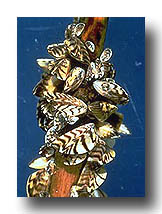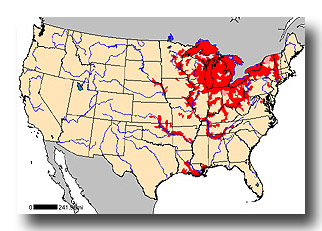|
Zebra Mussel Protection is now available in an eco friendly protective coating. The hydrophobic, low surface energy, non-stick properties
of Ecological Coating's Zebra Mussel Release Coating results in low bio-fouling adhesion. This is true for Zebra Mussels,
Quagga Mussels and all bacterial and algal bio-films. EC coatings are
water-based and non-toxic. Don't confuse our environmentally friendly coating
with those toxic Anti-Fouling coatings on the market which release copper to
kill organisms and are hazardous to the environment, thereby attempting to solve one problem
while creating another.
 Maintenance Friendly Maintenance Friendly
With hard abrasion resistant properties and its excellent adhesion to a wide range of substrates,
our
Zebra Mussel Coatings are conducive to repeated
cleaning by robust water jet. The lubricity of the coating makes cleaning much
easier by dramatically reducing friction. When applied in an environment with
flowing water, the non stick, antifoul properties allow the coating to be self
cleaning.
Low Environmental Impact
From the Low V.O.C. rating of the water based chemistry to its non-toxic,
non-leaching formulation, these immersion coatings have minimal environmental impact.
And Much More Too! ...
Our Zebra Mussel Release Coatings are actually a full
maintenance coating system with all the properties you would expect from a
premium maintenance coating system.
-
Corrosion resistance
-
Outdoor weathering resistance
-
Above and below water performance
-
Wide temperature operating range
-
Excellent thin film performance
|
4000 Series
Standard Colors |
|
DOVE
Grey |
BATTLESHIP
Grey |
GHARCOAL
Grey |
OCEAN
Blue
|
PLANKTON
Green
|

Background On Zebra Mussels

What
is a Zebra Mussel?
Zebra mussels are small shellfish named for the
striped pattern of their shells. They are typically found
attached to objects or each other by threads underneath the shells. Zebra
mussels are native to the Black, Caspian, and Azov Seas. Each Zebra Mussel spawns 40,000 to 60,000 eggs a year that
float as microscopic plankton until they find a secure place to attach.
 How and where have they spread? How and where have they spread?
By the late 18th and early 19th centuries, zebra
mussels had spread to most all major drainages of Europe because of widespread
construction of canal systems. They first appeared in Great Britain in 1824
where they are now well established. Since then, zebra mussels have expanded
their range into Denmark, Sweden, Finland, Ireland, Italy, and the rest of
western Europe. Zebra mussels were first discovered in North America in 1988 in
the Great Lakes. The first account of an established population came from
Canadian waters of Lake St. Clair, a water body connecting Lake Huron and Lake
Erie. A release of larval mussels during the ballast exchange of a single
commercial cargo ship traveling from the north shore of the Black Sea to the
Great Lakes has been deduced as the likely vector of introduction to North
America. By 1990, zebra mussels had been found in all the Great Lakes. The
following year, zebra mussels escaped the Great Lakes basin and found their way
into the Illinois and Hudson rivers. The Illinois River was the key to their
introduction into the Mississippi River drainage which covers over 1.2 million
square miles.
Have they caused significant damage yet?
Zebra mussels are notorious for their biofouling
capabilities by colonizing water supply pipes of hydroelectric and nuclear power
plants, public water supply plants, and industrial facilities. They colonize
pipes constricting flow, therefore reducing the intake in heat exchangers,
condensers, fire fighting equipment, and air conditioning and cooling systems.
Small mussels can get into engine cooling systems causing overheating and
damage. Estimates on the effect of the mussel invasion range from
$500 million to $5 billion per annum! The invasion is an ecological
disaster that is just starting. Navigational
buoys have been sunk under the weight of attached zebra mussels.
Zebra mussels have had a tremendous impact on
facilities that use raw surface water, such as utility plants, factories, and
water treatment plants. These mussels will attach and colonize inside water
intake pipes, wells, and screen systems. In addition to clogging pipes and
reducing the flow, zebra mussels infiltrate interior plant structures, causing
obstruction of pump valves and leading to failures of vital plant components.
This scenario occurred at the Monroe waterworks plant on Lake Erie. As a result,
the 24,000 residents of Monroe, Michigan experienced several water outages
during 1989 to 1991.
Is my business at risk?
If these mussels have infiltrated your area and
your business uses fresh water for
drinking purposes, cooling, process or emergency fire services, you could be
affected, directly or indirectly. It's much more cost effective to take preventative measures
than to cure a substantially infected system. Pro-act don't Re-act! Seek professional assistance and advice. The design and
installation of a suitable system will in all likelihood include a Release
Coating and we recommend our Zebra Mussel Release Coating, specifically
formulated to release Zebra and Quagga Fresh Water Mussels.
|
Orders | Information | Technical Support
To place an order for our Zebra Mussel Coatings, receive
additional product information or technical support, please contact
Ecological Coatings via phone or e-mail and one of our representatives
will be happy to assist you. |

|
Ecological
Coatings, LLC | P.O. Box 4202 |
Clifton Park, NY 12065 | 518-383-9585
EcologicalCoatings.com

E-Mail
Us |
|
